
Rhinoplasty, commonly known as a nose job, is a popular cosmetic and functional procedure that reshapes the nose for aesthetic or medical reasons. While many people achieve their desired results, it is crucial to understand the risks involved and how to avoid potential complications. This article will discuss the possible risks of rhinoplasty and provide essential tips to minimize complications.
Understanding the Risks of Rhinoplasty:
Like any surgical procedure, Rhinoplasty Dubai comes with its own set of risks. Being aware of these risks allows patients to make informed decisions and take necessary precautions.
Infection:
One of the most common risks associated with any surgery is infection. Although rare, infections can lead to complications such as delayed healing or the need for additional treatments.
Breathing Difficulties:
Since rhinoplasty alters the structure of the nose, some patients may experience difficulties with breathing, especially if too much cartilage or tissue is removed.
Poor Wound Healing and Scarring:
Depending on the technique used, visible scars may develop. Open rhinoplasty involves an incision on the columella, which can leave a small scar if not properly managed.
Asymmetry and Unsatisfactory Results:
Despite the surgeon’s expertise, some patients may not be satisfied with the final results. Asymmetry or unexpected changes in the nose’s shape may require revision surgery.
Numbness or Sensory Changes:
Temporary or permanent numbness around the nose or upper lip can occur due to nerve disruption during the procedure.
Excessive Bleeding or Hematoma:
Uncontrolled bleeding or blood pooling under the skin (hematoma) is another potential risk. This may lead to prolonged swelling or discomfort.
Anesthesia-Related Complications:
General anesthesia, which is commonly used for rhinoplasty, carries inherent risks, including allergic reactions and breathing issues.
Psychological and Emotional Impact:
Some patients experience emotional distress if the results do not meet their expectations, leading to anxiety, depression, or body image concerns.
How to Avoid Complications:
While it is impossible to eliminate all risks, following certain precautions can significantly reduce the likelihood of complications. Here’s how you can ensure a safer rhinoplasty experience:
Choose an Experienced and Qualified Surgeon:
Selecting a board-certified and experienced plastic surgeon is the most important step in ensuring a successful rhinoplasty. Research their credentials, read reviews, and ask to see before-and-after photos of previous patients.
Have a Thorough Consultation:
A detailed consultation allows you to discuss your goals, medical history, and any potential risks. Be honest about your expectations, and ensure you understand the limitations of the procedure.
Follow Pre-Surgery Instructions:
Your surgeon will provide guidelines to prepare for surgery. These may include:
- Avoiding smoking and alcohol, which can impair healing.
- Stopping blood-thinning medications like aspirin to reduce bleeding risks.
- Maintaining a healthy diet and hydration for optimal recovery.
Opt for a Personalized Approach:
Each patient has unique facial features, and a one-size-fits-all approach does not work for rhinoplasty. Work with your surgeon to develop a customized plan that suits your facial structure and needs.
Prioritize Post-Surgical Care:
Following post-operative care instructions is crucial for a smooth recovery. This includes:
- Keeping the head elevated to minimize swelling.
- Avoiding strenuous activities and heavy lifting for at least a few weeks.
- Using cold compresses to reduce bruising and discomfort.
- Taking prescribed medications as directed to manage pain and prevent infection.
Watch for Signs of Complications:
Be vigilant about any unusual symptoms after surgery. Contact your doctor immediately if you experience:
- Severe pain that does not subside with medication.
- Uncontrolled bleeding.
- Signs of infection, such as fever, redness, or pus from the incision site.
- Difficulty breathing that worsens over time.
Avoid Prematurely Judging the Results:
It takes time for the nose to settle into its final shape. Swelling can last several months, so patience is essential before assessing the outcome.
Consider Non-Surgical Alternatives:
For those hesitant about surgery, non-surgical Rhinoplasty in Dubai using dermal fillers can be an option. While not permanent, it allows minor shape modifications without the risks of surgery.
Rhinoplasty can be a life-changing procedure that enhances both aesthetics and functionality. However, understanding the potential risks and taking the right precautions is essential for a safe and satisfactory outcome. Choosing a skilled surgeon, following pre- and post-operative care, and maintaining realistic expectations are key factors in minimizing complications. By being well-informed and proactive, patients can achieve the best possible results while avoiding unnecessary risks.







